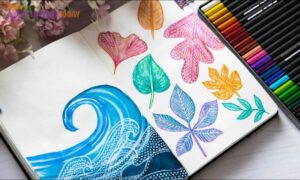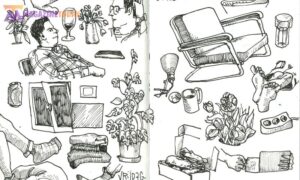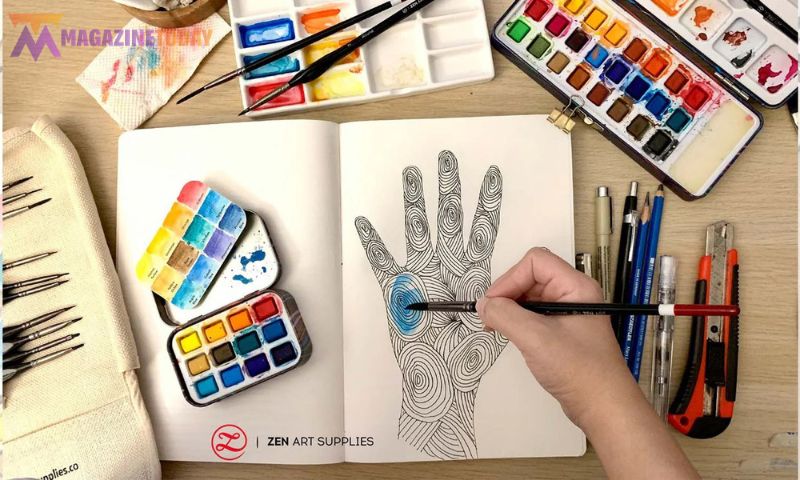A blank sketchbook holds endless possibilities, waiting for your creativity to transform its empty pages into a masterpiece. Whether you’re a beginner exploring the world of art or a seasoned artist seeking fresh inspiration, having a list of sketchbook ideas can spark your imagination and push your creativity to new heights.
In this comprehensive guide, we’ll explore over 200 sketchbook ideas across various themes, techniques, and styles to help you stay inspired. Let your sketchbook become a canvas for exploration, self-expression, and artistic growth.
Why Keep a Sketchbook?


A sketchbook is more than just a collection of drawings. It’s a creative space where you can:
Experiment: Test new techniques, mediums, and styles without pressure.
Record Ideas: Capture thoughts, inspirations, and visual concepts for future projects.
Improve Skills: Practice regularly to refine your artistic abilities.
Relax and De-Stress: Art can be therapeutic, providing a peaceful outlet for self-expression.
Now, let’s dive into the sketchbook ideas to ignite your creativity!
Simple and Beginner-Friendly Sketchbook Ideas
Everyday Objects
Draw household items like cups, shoes, or utensils.
Sketch items from your workspace or desk.
Nature Studies
Leaves, flowers, and trees in your backyard.
Study different types of clouds or rocks.
Food and Beverages
Illustrate your breakfast, lunch, or dinner.
Try drawing fruits, vegetables, or your favorite snacks.
Patterns and Doodles
Create repetitive patterns or mandalas.
Doodle random shapes and fill them with intricate details.
Basic Shapes and Forms
Practice drawing spheres, cubes, and cylinders.
Experiment with shading to create depth and dimension.
Creative Sketchbook Prompts for Intermediate Artists
Portrait Practice
Draw yourself or a family member.
Try different expressions like happiness, sadness, or surprise.
Animal Studies
Sketch your pet or animals you’ve seen at a zoo.
Focus on their unique features, like fur texture or facial expressions.
Urban Sketching
Capture scenes from your local park, coffee shop, or street corner.
Experiment with perspective and architectural details.
Illustrate a Quote
Pick a meaningful quote and turn it into a hand-lettered illustration.
Incorporate decorative elements like florals or geometric shapes.
Fantasy Worlds
Design mythical creatures, landscapes, or castles.
Combine elements from nature and your imagination.
Advanced Sketchbook Ideas for Experienced Artists
Master Studies
Recreate artwork from your favorite artists or historical masterpieces.
Analyze their techniques and adapt them to your style.
Abstract Art
Play with colors, textures, and shapes to create abstract compositions.
Use unconventional tools like sponges or palette knives.
Concept Art
Develop character designs for a story or game.
Sketch environments and props for fictional worlds.
Dynamic Poses
Draw figures in motion, such as dancers, athletes, or animals.
Practice capturing movement and energy in your sketches.
Mixed Media Experiments
Combine watercolors, ink, and collage in your sketchbook.
Add textures using fabric, thread, or paper cutouts.
Theme-Based Sketchbook Ideas
Seasons
Illustrate scenes representing spring, summer, fall, and winter.
Focus on seasonal elements like flowers, snowflakes, or beach vibes.
Travel Journal
Sketch landmarks, foods, and experiences from your travels.
Include maps and ticket stubs for a scrapbook effect.
Mythology and Folklore
Draw gods, goddesses, or mythical creatures from different cultures.
Reimagine traditional tales with a modern twist.
Sci-Fi and Space
Create futuristic cities, spaceships, or alien life forms.
Explore concepts like black holes or asteroid belts.
Daily Life Vignettes
Capture moments from your routine, like cooking, reading, or commuting.
Focus on storytelling through small details and compositions.
Experimenting with Techniques
Line Art
Use only lines to create intricate patterns and designs.
Experiment with thickness and spacing for variety.
Negative Space
Draw by focusing on the spaces around your subject.
Use contrasting colors to highlight the subject.
Continuous Line Drawing
Sketch your subject without lifting your pen or pencil.
Challenge yourself to create a complete composition in one stroke.
Blind Contour Drawing
Draw without looking at your sketchbook while focusing on the subject.
Embrace imperfections as part of the process.
Stippling and Hatching
Use dots or lines to create texture and shading.
Experiment with density and direction for different effects.
Incorporating Color into Your Sketchbook
Monochrome Studies
Choose one color and explore its various shades and tones.
Watercolor Washes
Add soft backgrounds to your sketches using watercolor techniques.
Experiment with gradients and layering.
Marker Blending
Use alcohol-based markers to blend colors seamlessly.
Practice creating smooth transitions and bold highlights.
Mixed Media Collages
Combine colored pencils, paints, and found materials in your sketches.
Use magazine cutouts or fabric swatches for added texture.
Color Themes
Dedicate pages to specific color palettes, like pastels or earth tones.
Explore the emotions and moods associated with different colors.
Drawing Challenges to Fill Your Sketchbook


30-Day Sketchbook Challenge
Dedicate each day to a new prompt, such as objects, landscapes, or abstract art.
Alphabet Art
Draw something that starts with each letter of the alphabet.
One Subject, Many Styles
Sketch the same object using different techniques, like realism, cubism, or impressionism.
Hourly Sketches
Create a small sketch every hour to document your day.
One-Line a Day
Add one line to your sketchbook daily, building a complete image over time.
FAQs
1. How Do I Overcome Artist’s Block?
- Start with simple prompts like everyday objects or patterns.
- Explore new techniques or tools to reignite your creativity.
2. What Materials Should I Use in My Sketchbook?
- Experiment with pencils, pens, markers, watercolors, or mixed media.
- Choose materials that suit your sketchbook’s paper type.
3. How Can I Make My Sketchbook Look Professional?
- Plan your compositions and use a consistent theme or color palette.
- Add finishing touches like borders or annotations.
4. Can I Use a Digital Sketchbook?
- Absolutely! Digital sketchbooks offer flexibility with tools and layers.
- Apps like Procreate or Adobe Fresco are great options.
5. How Often Should I Use My Sketchbook?
- Aim to sketch regularly, even if it’s just a few minutes a day.
- Consistency helps build habits and improve your skills.
Final Thoughts
A sketchbook is a personal sanctuary for creativity, exploration, and growth. By filling its pages with diverse ideas and techniques, you’ll not only sharpen your artistic skills but also create a visual diary of your journey as an artist. Whether you’re sketching everyday objects, experimenting with colors, or crafting elaborate fantasy worlds, let your sketchbook be a reflection of your imagination and passion.






